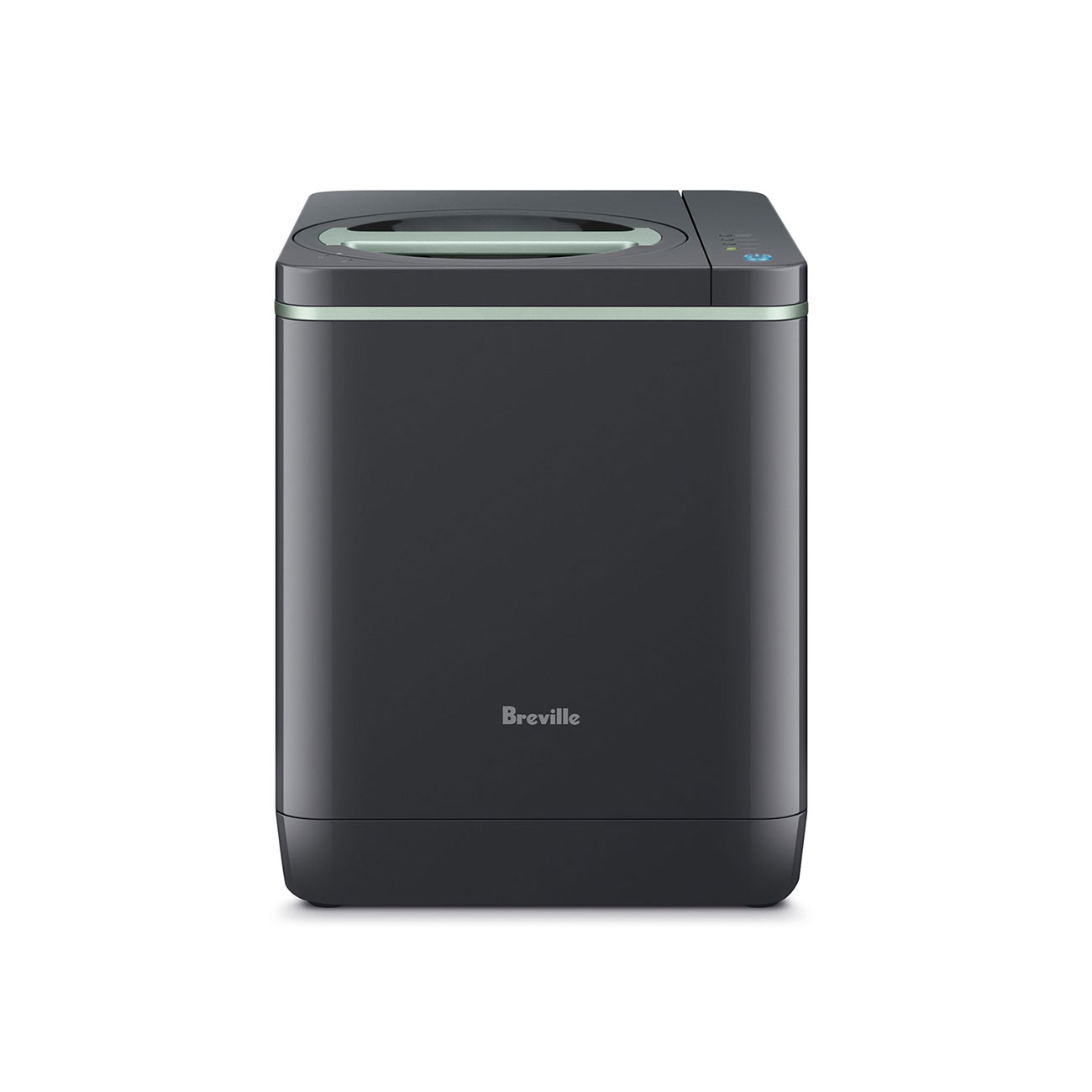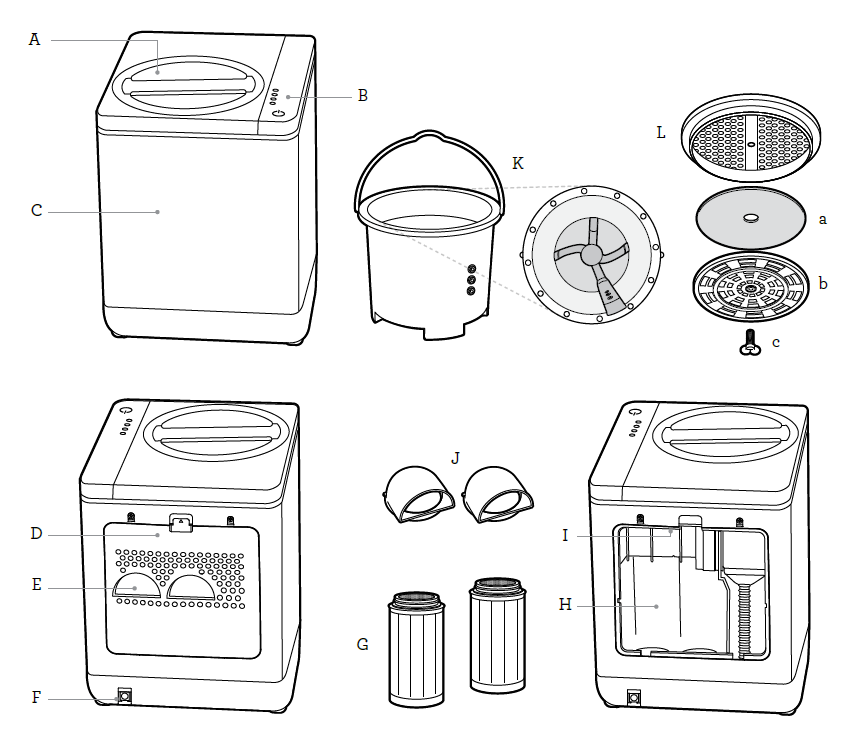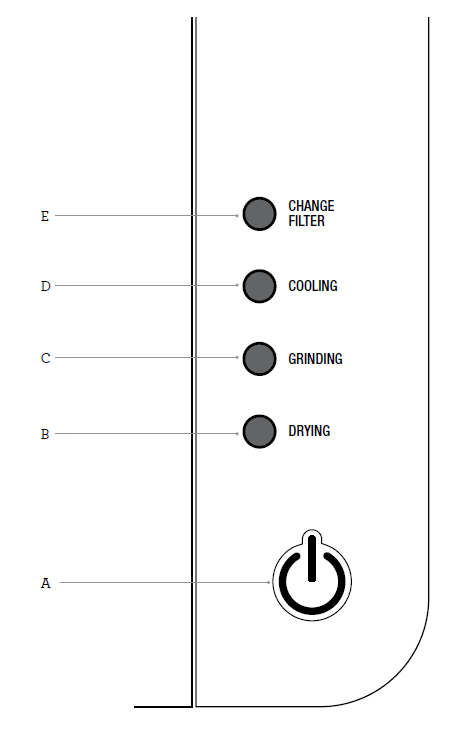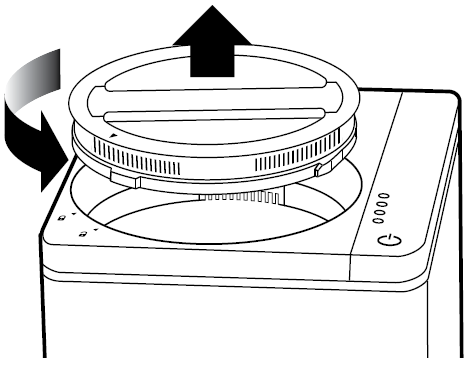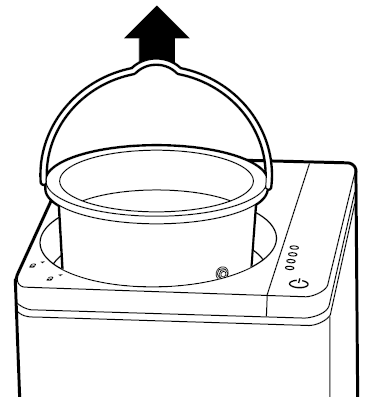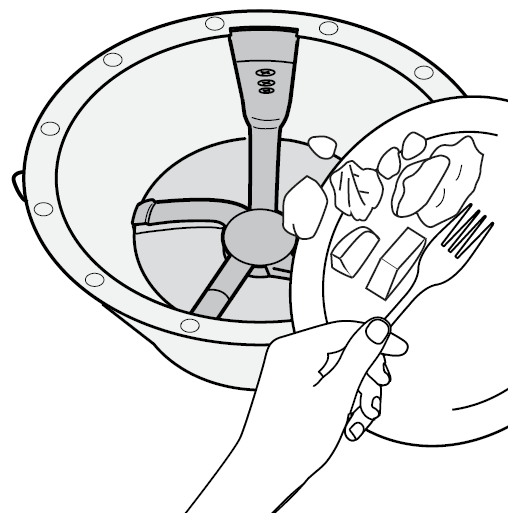Breville The FoodCycler
BREVILLE RECOMMENDS SAFETY FIRSTAt Breville we are very safety conscious. We design and manufacture consumer products with the safety of you, our valued customer, foremost in mind. In addition, we ask that you exercise a degree of care and adhere to the following precautions.
IMPORTANT SAFEGUARDS
READ ALL INSTRUCTIONS BEFORE USE AND SAVE FOR FUTURE REFERENCE
- Carefully read all instructions before operating the FoodCycler for the first time and save for future reference.
- Remove and safely discard any packing material, and promotional labels before using the FoodCycler for the first time.
- To eliminate a choking hazard for young children, remove and safely discard the protective cover fitted to the power plug of this appliance.
- Do not place the FoodCycler near the edge of a bench or table during operation.
- Ensure the surface is level, clean and free of water and other substances.
- Do not use the FoodCycler on a sink drain board.
- Do not place the FoodCycler on or near a hot gas or electric burner, or where it could touch another heated appliance.
- Do not operate the FoodCycler on an inclined surface. Do not move the FoodCycler while it is switched on.
- Do not cover the air vents while the FoodCycler is operating.
- Never use the FoodCycler without the bucket in place correctly.
- Never use the FoodCycler with an empty bucket.
- Never touch the inside of the FoodCycler while it is operating as it is very hot.
- Always operate the FoodCycler on a stable and heat resistant surface. Do not use on a cloth-covered surface, near curtains or other flammable materials.
- When using the FoodCycler, provide sufficient clearance (minimum 20cm) above and on all sides for air circulation.
- Hot air is released through the air vents on the rear side of the FoodCycler during operation. Always keep your hands and face at a safe distance from the hot air and from the air vents.
- Never use the FoodCycler without the rear air outlet cover installed as the inner accessible surface of the FoodCycler is very hot during, and sometime after, operation.
- Never attempt to remove the security seal sticker or open the side cover of the FoodCycler. Warranty void if seal is removed or damaged. Misuse may cause injury.
- Before starting to operate the FoodCycler each time, clean any dirt or food residue on the external surface of the bucket and the surface of the heating plate.
- The FoodCycler is designed for processing household FOOD WASTE only. Do not add non-food waste to the FoodCycler.
- Do not fill the bucket with hard food waste such as hard bones or other similar hard food waste as it may damage the bucket and the FoodCycler.
- Do not over-fill the bucket past the ‘Fill line’ marked on the interior of the bucket.
- Do not pack down food waste to keep it beneath the fill-line once full. Overloading the bucket may cause a jam and damage the motor and FoodCycler.
- Do not place anything on top of the FoodCycler.
- Do not place any part of the FoodCycler in the dishwasher except the bucket.
- To prevent burns or personal injury, always use protective hot pads or insulated oven mitts when inserting, removing or handling items from the FoodCycler when hot. Alternatively, allow the FoodCycler to cool down before handling.
- Always use extreme caution when removing any of the accessories or disposing of food waste from the bucket.
- It is recommended to use only the accessories supplied with this FoodCycler.
- The use of any accessory attachments not recommended by Breville may cause injuries.
- Do not attempt to operate the FoodCycler by any method other than those described in this book.
- Always ensure the FoodCycler is properly assembled before use. Follow the instructions provided in this book.
- The FoodCycler will not operate unless properly assembled with the lid locked in place.
- Ensure the FoodCycler lid is securely locked in place before operating.
- The FoodCycler is not intended to be operated by means of an external timer or separate remote-control system.
- Do not store any item on top of the FoodCycler when in use and when stored.
- Always ensure the FoodCycler has cooled, is turned off at the power outlet and the cord is unplugged from the power outlet before attempting to move the FoodCycler, when not in use, if left unattended and before disassembling, cleaning or storing.
- Do not place the FoodCycler in direct sunlight. Colour fading and discolouration may occur when the FoodCycler is consistently exposed to UV light.
- Keep the FoodCycler clean. Follow the cleaning instructions provided in this book.
SPECIFICATIONS
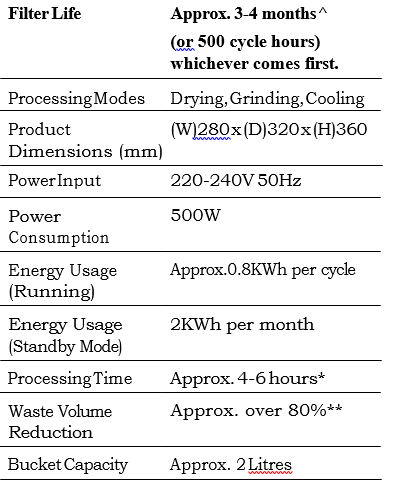
A filter replacement warning light will alert you when it is time to replace.* Typical processing time takes an average of 4-6 hours. Cycle time will vary depending on the types of food being processed and the total moisture content. Total maximum processing time is maximum 8 hours. The cooling phase takes up to an additional 30 minutes.** The volume of the bucket contents may be reduced by over 80% depending on the amount and moisture content of the food scraps being processed.
IMPORTANT SAFEGUARDS FOR ALL ELECTRICAL APPLIANCES
- Fully unwind the power cord before use.
- Connect only to a 230V or 240V power outlet.
- The appliance must be used on a properly grounded outlet. If it is not sure, please consult a qualified electrician.
- Do not, under any circumstances, modify the power plug or use a power plug adapter.
- Do not place this appliance on or near a heat source, such as hot plate, oven or heaters.
- Position the appliance at a minimum distance of 20cm away from walls, curtains and other heat or steam sensitive materials and provide adequate space above and on all sides for air circulation.
- Do not let the power cord hang over the edge of a bench or table, touch hot surfaces or become knotted.
- This appliance is for household use only. Do not use this appliance for anything other than its intended use. Do not use in moving vehicles or boats. Do not use outdoors. Misuse may cause injury.
- The appliance is not intended for use by persons (including children) with reduced physical, sensory or mental capabilities, or lack of experience and knowledge, unless they have been given supervision or instruction concerning use of the appliance by a person responsible for their safety.
- Children should be supervised to ensure that they do not play with the appliance.
- Always turn the appliance to the OFF position, switch off at the power outlet and unplug at the power outlet when the appliance is not in use.
- Before cleaning, always turn the appliance to the OFF position, switch off at the power outlet, unplug at the power outlet and remove the power cord, if detachable, from the appliance and allow all parts to cool.
- To protect against electric shock, do not immerse the power cord, power plug or appliance in water or any other liquid or allow moisture to come in contact with the parts, unless it is recommended in the cleaning instructions.
- Any maintenance other than cleaning should be performed at an authorised Breville Service Centre.
- It is recommended to regularly inspect the appliance. To avoid a hazard, do not use the appliance if power cord, power plug or appliance becomes damaged in any way. Return the entire appliance to the nearest authorised Breville Service Centre for examination and/or repair.
- The installation of a residual current device (safety switch) is recommended to provide additional safety protection when using electrical appliances. It is advisable that a safety switch with a rated residual operating current not exceeding 30mA be installed in the electrical circuit supplying the appliance. See a qualified electrician for professional advice.
- During electrical storms, the appliance should be disconnected from the power source at the wall socket to prevent any electrical surges that may arise during the storm and which may inadvertently cause damage to the appliance and its electronic componentry.
Components
- A. Locking Lid
- B. Control Panel
- C. Main Housing Body
- D. Back Panel
- E. Air Vents
- F. Power Cord Outlet
- G. Set of EcoFilters (LWR050BLK)
- H. Filter cavities
- I. Filter Reset Button
- J. Filter Air Guides
- K. Bucket with Agitators
- L. Bucket Lid Assembly
- a. Carbon Foam Lid Liner
- b. Back Cover
- c. Locking Screw
Control Panel
- A. Power On/Off button with indicator light
- B. Drying indicator light
- C. Grinding indicator light
- D. Cooling indicator light
- E. Change filter indicator light
Features
YOUR BREVILLE FOODCYCLERYour Breville FoodCycler transforms your household food waste into nutrient rich EcoChipsâ„¢, using an intuitive three stage cycle. The FoodCycler pulverizes and dehydrates nearly all types of food waste.Agitators turn inside the grinding bucket, reducing food waste to small particles, while simultaneously the FoodCycler aerates and heats the bucket content, decomposing and sterilising the food waste.
Stage 1- DryingDehydrates household food wasteStage 2- GrindingGrinds food waste down by over 80% of the original volume**Stage 3- CoolingCools down the remaining EcoChipsâ„¢ for safe disposal** The volume of the bucket contents may be reduced by over 80% depending on the amount and moisture content of the food scraps being processed.The FoodCycler comes equipped with the following items:Removable, porcelain-coated aluminium bucketThe grinding bucket is designed to fully grind and process food waste, with perfectly calibrated resistance and strength testing.
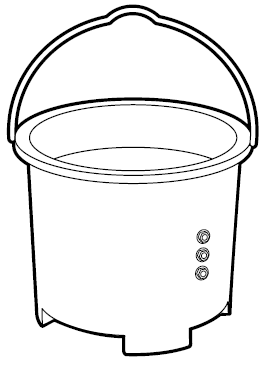
Carbon Filter Bucket LidComplete with an activated carbon foam lid-liner to capture odours, the versatile carbon filter bucket lid allows for accumulating food waste outside of the FoodCycler until ready to start your next cycle. Keep the bucket on its own on your benchtop using the carbon filtered lid while you accumulate your daily food waste, then when full, place the bucket in the FoodCycler to process (remove bucket lid before placing into FoodCycler).
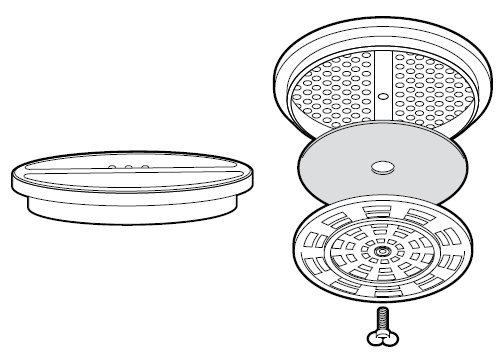
A set of 2 activated carbon EcoFilters (LWR050BLK)Activated carbon Filters are designed to reduce odours during cycling.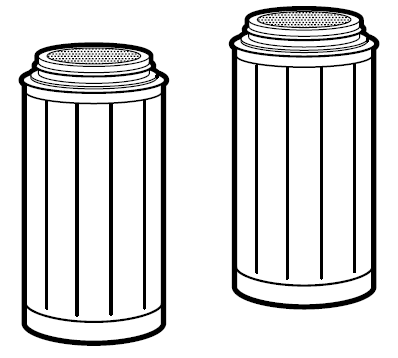
Filter Air GuidesTwo small air guide covers sit on top of the carbon filters, ensuring that the air and water vapour is properly directed toward the FoodCycler vents.
Locking LidSeamless design, slides and locks smoothly into place prior to every cycle to help insulate sound, reduce odours, and ensuring a safe, reliable cycle. Removing the lid will pause operation.
Each one of these parts forms the complete FoodCycler system.
Assembly
BEFORE FIRST USE
IMPORTANTEnsure all packaging is removed from the FoodCycler, EcoFilters and filter air guides before using.
- Remove and safely discard any packaging material or promotional labels attached to your FoodCycler.
- Remove the stickers located on the top of the two activated carbon EcoFilters that come fitted in the FoodCycler and ensure that the filters and filter air guides are in place before first use.
- Follow the direction found in Replacing the Filters on page 14.
IMPORTANT: Failure to remove the stickers located at the top of each of the filters before first use may impede air flow and cause the FoodCycler to fail to operate properly.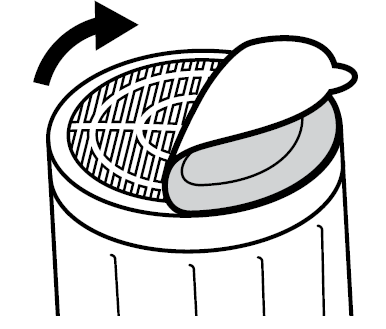
- Select a flat, level and dry location for the FoodCycler.
- For proper air flow, locate the FoodCycler at least 20cm from any wall or furniture.
- Ensure the air inlet and outlets are not blocked before use.
NOTE: When moving the FoodCycler, always lift using two hands under the base and set down gently on a flat, level and dry surface.
Functions
OPERATING YOUR FOODCYCLER
- Open the lid by turning counter-clockwise until the arrow on the bucket lid is facing the unlock symbol pictured on the top part of the FoodCycler. Lift to remove.

- Lift the bucket up straight and away from the FoodCycler using the folding metal handle.

- Add your food waste into the bucket. Do not load the bucket beyond the marked fïll line.

IMPORTANTBefore starting to operate the FoodCycler each time, clean any dirt or food residue on the external surface of the bucket and the surface of the heating plate.
What can the FoodCycler process
- Meat fish and poultry scraps (no bones)
- Most fruit and vegetable scraps, including peels
- Cereals and grains
- Cheese
- Beans, seeds and legumes
- Coffee grounds and paper tea bags
- Eggs and eggshells
- Pet food (no bones)
What can’t the FoodCycler process
- Hard bones such as beef, lamb and pig bones.
- Candy or gum
- Cooking oils or greases
- Hard pits (peaches, apricots, nectarines)
- Nuts and other hard shells
- Hard fruit and vegetable leaves (example, pineapple leaves)
IMPORTANTThe FoodCycler is designed for processing household FOOD WASTE only. Do not add non-food waste to the FoodCycler.The FoodCycler can handle organic materials that traditional composters can’t and performs best when fed a wide variety of foods.To ensure optimal food waste breakdown, mix food waste together, with heavier foods interspersed with lighter, dryer foods.
Avoid high concentrations of the following foods:
- starches (bread, cake, rice, pasta, mashed potatoes, stuffing)
- citrus fruit rinds
- condiments, dressings, sauces & soups
- nut butters
- jam, jellies, marmalades
- high sugar fruits (grapes, cherries, melon, oranges, bananas, etc.)
- meat, dairy and eggshells- sour creams, yogurts, spoiled milk.
- The dense, starchy and/or moisture-rich composition of these foods make them difficult to process in large quantities.
IMPORTANTWhen processing food waste that is high in starches and sugar, sauces or fatty food waste, be sure to mix them with other food waste. If these types of food waste are processed without mixing, there is a chance that the end product may become stuck to the bottom of the bucket and fail to process entirely.If your end product comes out less than optimal, simply add more food waste and start the cycle again. Be sure to cut up long food waste such as corn cobs, corn husks, etc. into smaller pieces as these items are highly fibrous and may cause a jam if left whole.
IMPORTANTAlways ensure that no food waste falls outside of the bucket and into the FoodCycler.This may cause damage to the motor and other internal components. You should remove the bucket from the FoodCycler prior to adding food waste. You can keep the bucket on your kitchen benchtop and fill with food wastethroughout the day/week until you are ready to start a cycle by using the carbon filtered bucket lid.IMPORTANTDo not overfill your bucket.The bucket comes with a full line (approx.2 Litres capacity) inside along the interior of the bucket. Do not add food waste above this line. Do not pack down food waste to keep it beneath the full line once full. Overfilling the bucket might cause the FoodCycler to jam and not process.

Replace the FoodCycler lid by inserting it into the top of the FoodCycler over the bucket. Turn the lid clockwise until the arrow on the lid aligns with the lock symbol picture on the top part of the FoodCycler.
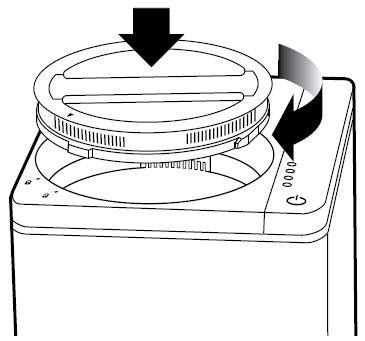
NOTE: The FoodCycler will not operate without locking the lid properly in position.
- Plug the power plug into a 230V or 240V power outlet and turn the outlet on.
- Press the Power On/Off button once to turn the FoodCycler on to Ready mode and the fan is running in low speed. The light will illuminate.
- Press the Power button again and the 3-stage cycling will start with a green light illuminating against each cycle.

- The FoodCycler will transition through 3 cycles – drying, grinding and cooling – then beep once when all cycles are complete and revert to Standby mode. All lights turn off and the FoodCycler shuts off. To turn the FoodCycler off manually, press and hold the Power On/Off button for 3 seconds. Turn off at the power outlet and unplug before opening the lid and removing the bucket.
Pause FeatureIf you find that you have more waste to add to your cycle while the FoodCycler is running, you can use your FoodCycler’s Pause feature.Pause feature should only be performed during drying cycle, otherwise the new food scraps will not be processed properly. Pausing the FoodCycler to add more food scraps will impact the accuracy of the cycle time, which will extend the overall cycle period (though the cycle will never last longer than 8 hours).The EcoChips may not be fully processed by the end of the cycle. In this case, you may want to run the FoodCycler a second time to completely dehydrate the bucket contents.To Pause the FoodCycler, press the Power On/Off button once or open the lid while the unit is processing. Pressing the Power On/Off button once again after locking the lid back in place will resume processing.
IMPORTANTIf the FoodCycler is overloaded or operated continuously for too long, the safety cut-out switch will stop the FoodCycler to prevent the motor from overheating. If this occurs, switch the FoodCycler off, unplug from the power outlet and allow to cool for approximately 30 minutes. Once the motor has fully cooled, it is ready for use again. If overheating is caused by the bucket being overfilled, remove some of the food waste and process in smaller batches.
Control Panel Indicator Lights and Cycle Time
- The Power On/Off button (blue light) will illuminate when the FoodCycler is in Standby mode or in operating.
- The Drying cycle (green light) can last anywhere between 60-100 minutes and will automatically move to Grinding once cycle has finished.
- The Grinding cycle (green light) is the longest cycle and can last anywhere between 4-6hours. Once this cycle is complete, the FoodCycler will move automatically to Cooling.
- The Cooling cycle (green light) is the last cycle before completion. The Cooling mode lasts under 30 minutes.
- The Change Filter light (red) will illuminate when it is time to replace the filters.

NOTETypical processing time takes an average of 4 – 6 hours. Cycle time will vary depending on the types of food being processed and the total moisture content. Total maximum processing time is 8 hours. The cooling phase takes up to an additional 30 minutes.
REPLACING THE FILTERS
Your EcoFilters should be replaced regularly or as indicated to ensure an odourless cycle. If the FoodCycler is used regularly, the filters will need to be changed every 3-4 months (500 Cycle Hours).At the end of this period, the Change Filter light will illuminate red indicating that the filters need to be replaced.
- Remove all packaging from the EcoFilters and Filter Air Guides before first use. Remove all packaging from replacement filters before fitting into the FoodCycler. Follow the steps described below.
To replace the EcoFilters:
- Open the back panel of the FoodCycler by pressing down on the plastic tab at the top of the panel (with the arrow), then pull outwards to release. Remove the two filter air guides sitting on top of the filters by tilting slightly towards you, then lift them up and out of the FoodCycler. Do not discard the filter air guides.
- Keeping the used filters straight, twist each of them counter-clockwise to remove from the filter cavities. Remove one at a time.
- Remove the packaging from the filters before setting. Keeping the new filters straight, insert the right, then the left, into the filter cavities and twist clockwise to secure.
- Slide the fïlter air guides over the top of the filters so they sit straight. Push down slightly to fit.
Care, Cleaning & Storage
Keeping your FoodCycler clean will help ensure that your FoodCycler performs cleanly and efficiently. Both the exterior of the FoodCycler and the removable bucket should be cleaned regularly.
NOTE: Before starting to operate your FoodCycler for each time, clean the bottom of the grinding bucket and the surface of the heating plate using a clean and dry cloth.Follow the directions below to keep your FoodCycler looking (and working) at its best.Always ensure the FoodCycler is turned off, switched off at the power outlet and unplugged and allow the FoodCycler to cool before performing any cleaning or filter replacement.
Cleaning the outside of the FoodCycler
WARNINGDO NOT immerse your FoodCycler FoodCycler in water. This will damage your FoodCycler beyond repair and might cause electric shock. Exterior, cosmetic cleaning only!NOTEUse a clean, dry cloth to clean external surface, internal surface and heating plate surface of the FoodCycler. With particularly stubborn grime, you can add a small amount of dish soap to your damp dish cloth before thoroughly wringing out most of the moisture.NOTEExposure to cooking oils and cleaning chemicals may cause colour fading and discolouration to the FoodCycler. If the FoodCycler is exposed to oils or chemicals, turn off and unplug the appliance and use a damp cloth to clean the external surface of the FoodCycler. Dry thoroughly using a dry, lint-free cloth or paper towel to remove all moisture before use.DO NOT use gasoline, benzine, thinner, harsh cleaners, etc. on and/or in the FoodCycler while cleaning as they will damage the FoodCycler.NEVER use alcohol or other solvents on this FoodCycler.Cleaning the Grinding Bucket The grinding bucket is made from tough aluminium with a protective porcelain coating, making your bucket dishwasher friendly for ultimate convenience.Allow your bucket to cool before handling, or placing it back in your FoodCycler.
- Remove bucket.
- Remove all blockages and loose particles from grinding bucket.
- Place bucket in lower rack of dishwasher.
If you find that the bucket contains a residue from the previous cycle and you would like to remove it, you can run a cycle with only citrus rinds (lemons, orange, etc.). The citrus peels will help clear any residue or caked-on food waste.If a jam occurs and you cannot remove the blockage manually, soak the bucket overnight in warm water (soap optional). Avoid using metal tools or metal wire brushes to clear out the blockage.You can also hand wash your bucket using warm water, a small amount of dish soap and a dish cloth. Scrub around and beneath the agitators as much as possible to clean all available surfaces.
Breville Customer Service Centre
Australian
Customers Phone: 1300 139 798
Web: www.breville.com

Breville, the Breville logo, EcoChips and EcoFilters are trademarks of Breville Pty. Ltd. A.B.N. 98 000 092 928.FoodCycler is a trademark of Food Cycle Sciences Corporation. All other brands may be trademarks of their respective owners. Due to continued product improvement, the products illustrated/photographed in this bookletmay vary slightly from the actual product.
References
[xyz-ips snippet=”download-snippet”]


